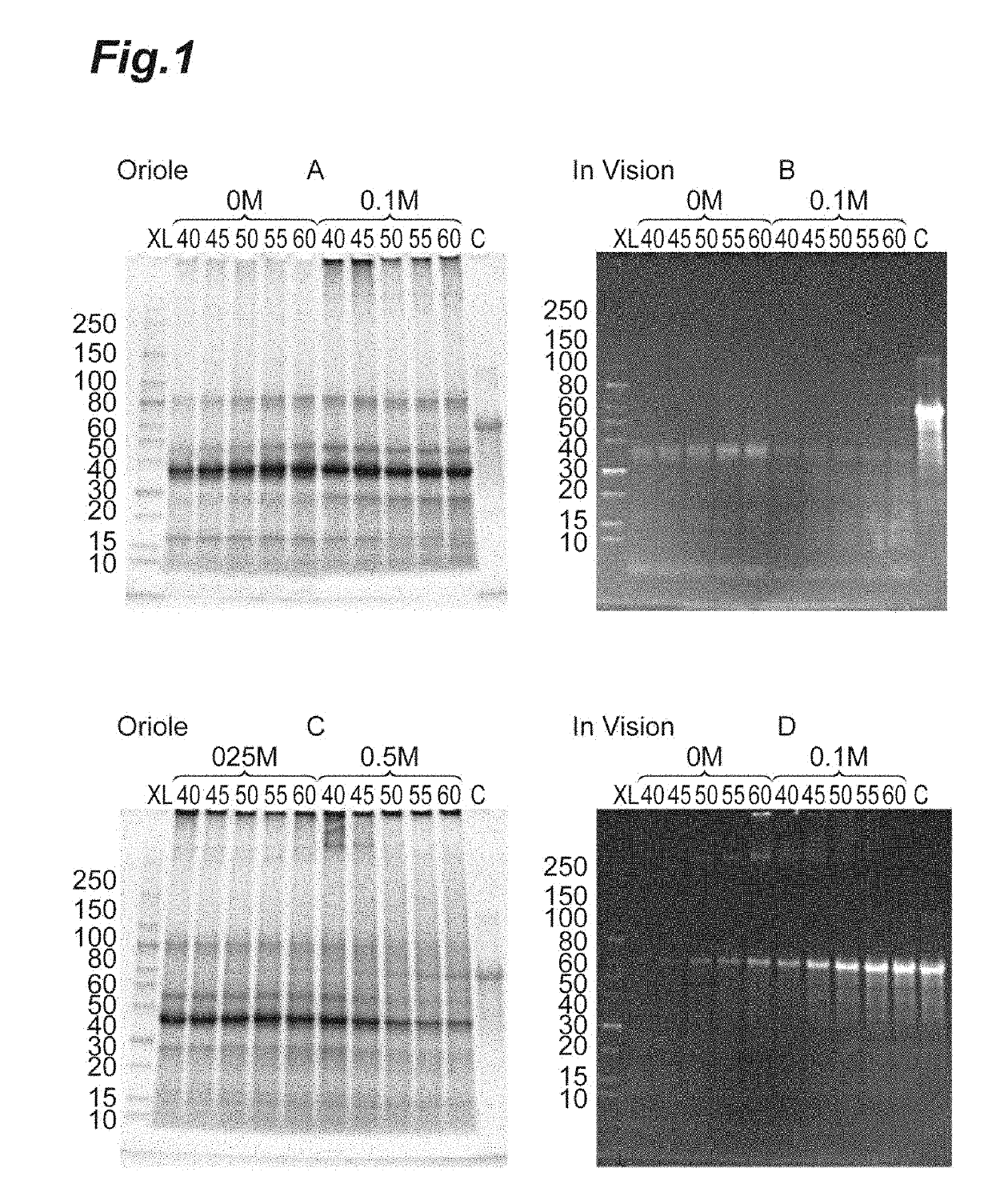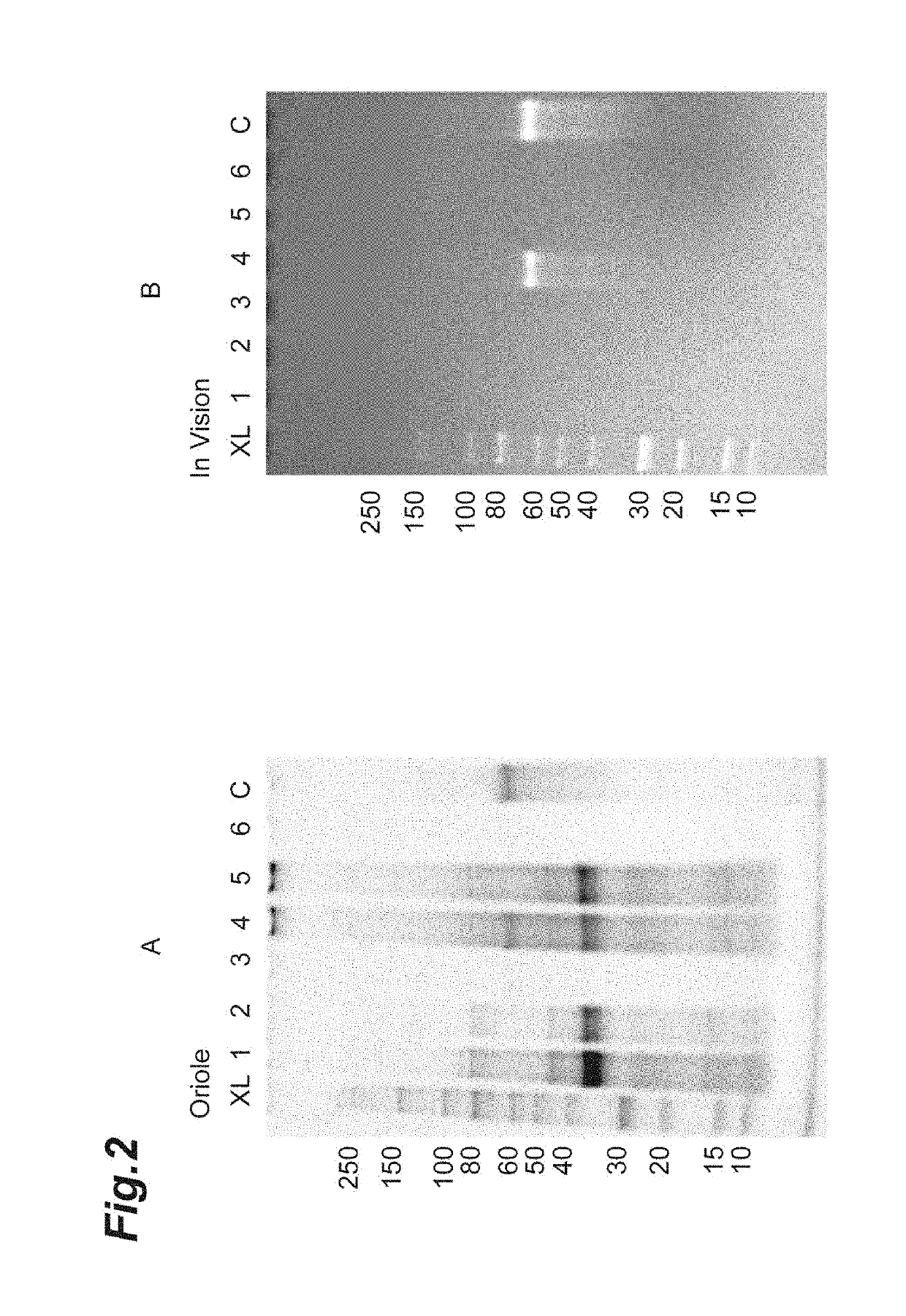Method for Purifying Recombinant Protein
a recombinant protein and purification method technology, applied in the field of purifying a recombinant protein, can solve the problems of low purity of the isolated protein of interest, limited isolatable proteins, and limited protein of interest, and achieves low purity, no complicated steps, and few steps.
- Summary
- Abstract
- Description
- Claims
- Application Information
AI Technical Summary
Benefits of technology
Problems solved by technology
Method used
Image
Examples
example 1 influence
of Inorganic Salt and Temperature on the Dissolving Step of Host Cell-Derived Protein
[0182]The influence of the addition of an inorganic salt to the first aprotic polar solvent and the addition concentration, as well as the temperature in the step of dissolving the protein derived from the host cell was investigated. 1 ml of DMSO containing 0, 0.1, 0.25 and 0.5 M lithium chloride was added to 50 mg of dried bacterial cells of PRT468 expressing Escherichia coli and treated at the temperatures of 40, 45, 50, 55 and 60° C. for 30 min After cooling to room temperature, centrifugation was performed under the conditions of 11,000×g and 5 min. The supernatant obtained by centrifugation (first soluble fraction) was analyzed by SDS-PAGE. The results are shown in FIG. 1. The numbers from 40 to 60 indicate the temperature, and the notation of 0 to 0.5 M indicates the concentration of lithium chloride contained in DMSO. Lane XL is the lane where a molecular weight marker protein has migrated, a...
example 2
First Effect of the Addition of Cyclohexanone in the Dissolution Step of the Protein Derived from the Host Cell
[0185]In Example 1, when DMSO containing a high concentration of lithium chloride was used as the first aprotic polar solvent, not only the protein derived from the host cell but also the protein of interest PRT468 was dissolved. Therefore, the effect on preventing the dissolution of PRT468 by adding cyclohexanone to DMSO containing a high concentration of lithium chloride was examined.
[0186]Solvents with three mixing ratios of DMSO: cyclohexanone=100:0, 50:50 and 25:75 were prepared, and lithium chloride was added to these solvents to be 0.1 or 0.5 M, and a total of 6 types of first aprotic polar solvent were prepared (see Table 5).
TABLE 5Lane No.Lithium chloride (M)DMSO (%)Cyclohexanone (%)10.1100020.1505030.1257540.5100050.5505060.52575
[0187]1 mL of the first aprotic polar solvents shown in Table 5 was added to 50 mg of dried bacterial cells of PRT468-expressing Escheric...
example 3 influence
of the Type of Aprotic Polar Solvent in the Step of Dissolving the Protein Derived from Host Cell
[0192]It was examined whether the protein derived from the host cell and the protein of interest can be efficiently separated when DMF was used as the first aprotic polar solvent. 1 mL of DMF (first aprotic polar solvent) containing 0, 0.1, 0.25 and 0.5 M lithium chloride was added to 50 mg of dried bacterial cells of PRT468-expressing Escherichia coli and treated at a temperature of 60° C. for 30 min. After cooling to room temperature, centrifugation was performed at 11,000×g for 5 min. 0.5 mL of the first aprotic polar solvent used were each added to the precipitate fraction obtained by centrifugation and suspended, then centrifuged again, followed by washing of the precipitate fraction. The obtained supernatant fraction (first soluble fraction) and precipitate fraction (first insoluble fraction) were analyzed by SDS-PAGE. The result of the supernatant fraction is shown in FIG. 4, and ...
PUM
| Property | Measurement | Unit |
|---|---|---|
| dipole moment | aaaaa | aaaaa |
| culture temperature | aaaaa | aaaaa |
| culture temperature | aaaaa | aaaaa |
Abstract
Description
Claims
Application Information
 Login to View More
Login to View More - R&D
- Intellectual Property
- Life Sciences
- Materials
- Tech Scout
- Unparalleled Data Quality
- Higher Quality Content
- 60% Fewer Hallucinations
Browse by: Latest US Patents, China's latest patents, Technical Efficacy Thesaurus, Application Domain, Technology Topic, Popular Technical Reports.
© 2025 PatSnap. All rights reserved.Legal|Privacy policy|Modern Slavery Act Transparency Statement|Sitemap|About US| Contact US: help@patsnap.com



